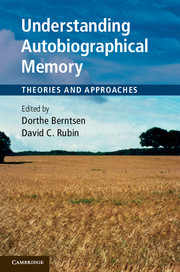Book contents
- Frontmatter
- Contents
- List of figures
- List of tables
- List of contributors
- Preface
- Acknowledgements
- 1 Introduction
- Part I Approaches to the study of autobiographical memory
- Part II Neural studies of autobiographical memory
- Part III Social and cultural aspects of autobiographical memory
- 8 Of sins and virtues: memory and collective identity
- 9 Historically defined autobiographical periods: their origins and implications
- 10 Directive functions of autobiographical memory: theory and method
- Part IV Development of autobiographical memory from infancy to old age
- Part V Evolution and basic processes of autobiographical memory
- Part VI Discussion
- Index
- References
10 - Directive functions of autobiographical memory: theory and method
Published online by Cambridge University Press: 05 November 2012
- Frontmatter
- Contents
- List of figures
- List of tables
- List of contributors
- Preface
- Acknowledgements
- 1 Introduction
- Part I Approaches to the study of autobiographical memory
- Part II Neural studies of autobiographical memory
- Part III Social and cultural aspects of autobiographical memory
- 8 Of sins and virtues: memory and collective identity
- 9 Historically defined autobiographical periods: their origins and implications
- 10 Directive functions of autobiographical memory: theory and method
- Part IV Development of autobiographical memory from infancy to old age
- Part V Evolution and basic processes of autobiographical memory
- Part VI Discussion
- Index
- References
Summary
In 1929, at the age of 4 years, prominent African-American activist Malcolm X experienced a horrifying event that became his “earliest vivid memory”:
I remember being suddenly snatched awake into a frightening confusion of pistol shots and shouting and smoke and flames. My father had shouted and shot at the two white men who had set the fire and were running away. Our home was burning down around us. We were lunging and bumping and tumbling all over each other trying to escape. My mother, with the baby in her arms, just made it into the yard before the house crashed in, showering sparks. I remember we were outside in the night in our underwear, crying and yelling our heads off. The white police and firemen came and stood around watching as the house burned down to the ground.
(Malcolm X, 1965, pp. 5–6)Why was this early childhood experience so memorable? One answer to this question focuses on well-known and carefully studied mental and affective processes known to enhance memory vividness (e.g., Rubin and Kozin, 1984). The episode was highly emotional; it was distinctive and unique; it carried immense personal and familial importance; and as a result it was repeatedly thought about, talked about, and written about in the years that followed. The memory represents these qualities so strongly that it would be far more difficult to explain its absence than its prominent place in Malcolm’s life history.
A second answer to the question of why the episode was vividly remembered focuses on adaptive functions rather than mental processes. Autobiographical memory is much more than a passive record of things that happened years ago – it also actively influences current thoughts, attitudes, and behaviors. Malcolm X’s memory seemed to anchor a continuing set of attitudes and deeply felt feelings that helped to set the course of his career as an activist and leader (Pillemer, 1998, pp. 75–76). He referred back to episodes of childhood trauma and harassment when speaking publicly about racial hatred and injustice (Malcolm X, 1965, p. 6).
- Type
- Chapter
- Information
- Understanding Autobiographical MemoryTheories and Approaches, pp. 181 - 202Publisher: Cambridge University PressPrint publication year: 2012
References
- 8
- Cited by

